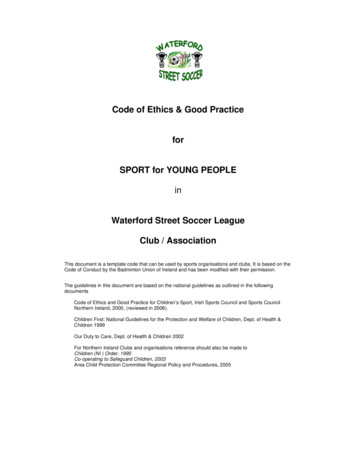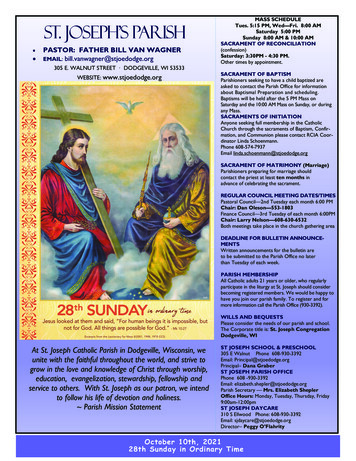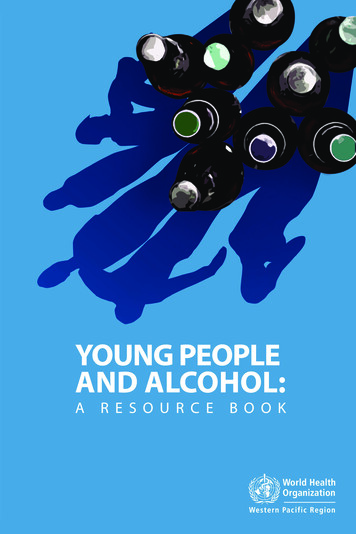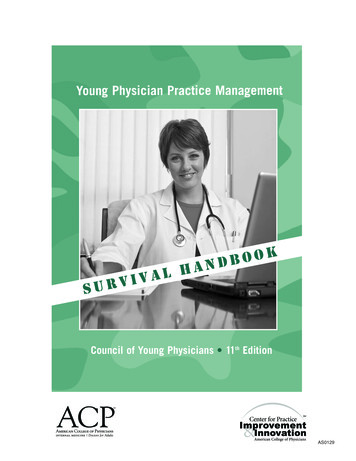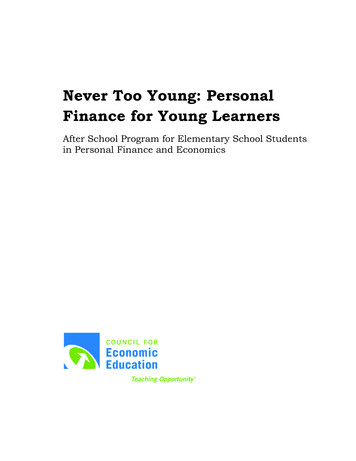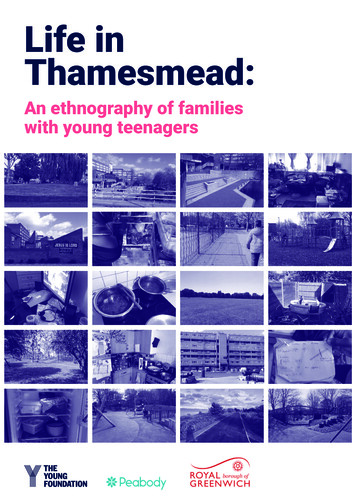
Transcription
Life inThamesmead:An ethnography of familieswith young teenagers
2Life in Thamesmead: An ethnography of families with young teenagers
ForewordThroughout our history Peabody has strivedto deliver the best possible support to thosewho need it most.This has meant really getting to knowour residents and communities so weunderstand their needs and concerns.We do this in a number of ways ranging fromthe delivery of front-line services to moreformal research, such as this importantpiece of work from The Young Foundation,which was commissioned in conjunctionwith the Royal Borough of Greenwich.Studies like this give us a deeperunderstanding of communities and enableus to shape our services to better supportresidents and others.They also help us identify the individualchallenges, issues and opportunities thatmake each place unique. For example, wehave learnt that in Thamesmead, residents inThe Moorings enjoy the green open spacesand appreciate it being a calm, quiet andpeaceful place. They also identify areas forimprovement such as: removing barriersto work, keeping people better informed,supporting increased cohesion andaddressing safety concerns.We will put a plan in place to ensurelocal people are regularly updated aboutdevelopments, have opportunities to be moreinvolved in what happens in their communityand access to the tools they need to livehealthier and happier lives.Through the Moorings Children’s Community,we will continue to work with the RoyalBorough of Greenwich and our partners toensure families are supported and youngpeople grow up to be successful andaspiring adults.Stephen Burns,Executive Director,Care and Communities, Peabody.The study also highlights understandableuncertainties about the regeneration activityand large scale change in the area, includingwhat it will mean for the future.These insights will help to inform theservices we provide, the partners we workwith and the way we continue to support ourresidents and the wider community.3
Introduction toThamesmeadThamesmead in South-East London wasoriginally developed by the Greater LondonCouncil in the 1960s to house London’sgrowing population. It spans almost 760hectares, 65% of which is owned by Peabody,and is home to an ethnically diversecommunity of 45,000 people.Many of the white working class residents,who make up 42% of the population,arrived in Thamesmead and The Mooringsneighbourhood in the 1960s and 1970sfrom the overcrowded terraced houses ofEast London. Recently, the area has becomemore ethnically diverse: in the latest census58% of the neighbourhood describedtheir ethnicity as non-white and 12% ofhouseholds do not have English as a mainlanguage. 36% of the population identifiesas black African and 4% as black Caribbean(ONS Census: 2011i).Thamesmead has an abundance of greenopen spaces and direct access to the riverThames. At the same time it faces a numberof challenges, including being situatedin the centre of the 15 mile gap betweenthe Blackwall and the Dartford Tunnels.Geographic and transport features reduceresident mobility, and may help to explainwhy only 36% of residents aged 16-74 are infull-time employment (ONS Census: 2011).in private rented accommodation (ONSCensus: 2011). Child poverty has reducedin the last five years but is still higher thanacross London with 21% of children in TheMoorings ward living in poverty (HMRC:2016iii ). In terms of education, only 32%of residents have a Level 4 (post-college)qualification or above, in comparison with38% of Londoners (ONS Census: 2011).Thamesmead is currently undergoing aregeneration programme led by Peabodywhose mission is to make a lastingcontribution to the physical, social andenvironmental wellbeing of the area.As part of a 30-year plan for Thamesmead,billions of pounds is being invested inrepairing existing houses, improving publicspaces, building 20,000 new homes, lookingafter parks and waterways and growingsocio-economic activity. Regeneration willalso include the connection of Abbey Woodto the Crossrail line.These changes present a significantopportunity to improve socio-economicoutcomes for families and children fromdisadvantaged backgrounds living locally.The area is classified as amongst the mostdeprived 40% of neighbourhoods in England(HMRC: 2019ii ), with 38% of residents livingin social rented properties and 25% living4i The majority of the data available at ward level is drawn from the 2011 census. Whilst this data is likely to have changed since 2011, it iscurrently the most robust data available for The Moorings.iiEnglish Indices of Deprivation (2019), HMRCiiiChildren in Poverty, Borough and Ward (2016), HMRCLife in Thamesmead: An ethnography of families with young teenagers
The research approachLife in Thamesmead is a research studyjointly commissioned by Peabody andRoyal Borough of Greenwich to explore thelived experiences of 18 families living inThamesmead. This research will be usedto inform and shape the Royal Borough ofGreenwich’s strategic plans and servicesserving children and young people, as wellas the community regeneration programmessupported by Peabody and its partners, nowand in the future.The Young Foundation was commissionedto conduct the research, which focused onthree key areas:1. Families’ experiences around parenting,education in school, home learning andhomework.2. Families’ views on health and wellbeing;mental and physical health as well asexperiences or perceptions of barriersand facilitators to being healthy.3. Families’ experiences of living inThamesmead and engagement withPeabody and other housing andcommunity services, different aspirationswithin the community, communitycohesion, and where families turn to forsupport.parent(s), and one interview with the child.All families involved live within ThamesmeadMoorings ward and have a child in Year 7, 8 or9 at a secondary school in the Royal Boroughof Greenwichi . The two interview visits tookplace a week apart, during which time thechild was asked to create a photo diary inresponse to a series of questions about thearea in which they live.Photos from these photo diaries are includedthroughout the report. Half of families we spoke to areheaded by a single mum The average number of childrenper family is 3.8 The average number of kids stillliving at home is 2.9 On average, 4.5 people live ineach household Over half of mums are ‘gapmums’ with both teenagers andchildren under sixThe ethnographic research was conductedover a period of six months and aimedto produce rich and authentic insightsinto the lived experiences of residents inThamesmead.Who we spoke toOur researchers spoke to 18 families fromdifferent backgrounds including those withblack African, black Caribbean, white andmixed-ethnicity heritage. Three conversationalinterviews were conducted with each familyin their own homes: two interviews with theiWith the exception of one child, who was currently home schooled but had been previously enrolled in a Greenwich school5
6Isabella & Faye:Mum, 4 kids at home (Boys14 and 7. Girls 13 and 6),1 son, 19, lives with GrandmaLara, Mark & Jason:Mum, Dad, 3 kids at home(Boy 14 and 2 younger kids)Keisha, Paul & Leiah:Mum, Dad, 3 kids at home(Girls, 12, 8, 6)Melody, Thomas & Adeyemi:Mum, Dad, 3 kids at home(Boys 12 and 6, baby girl)Kimberley & Chris:Mum, 2 kids at home(Boys 13, 7)Alondra & Marlon:Mum, 2 kids at home(Boys 12, 3)Ruby & Emma:Mum, 4 kids at home(Girls 13, 4. Boys 16, 9)Jennifer, Ian & Brian:Mum, Dad, 3 kids at home(Boy 14, two younger kids)Eva & LilianaMum, 3 kids at home(Girl, 13, 2 younger kids)Sophie & Ben:Mum, step Dad, 3 kids athome (Boys 13, 9. Girl 6)Laila, Abdul & Halimah:Mum, Dad, 4 girls at home(12, 10, 8, 4)Teresa & Jake:Mum, 2 kids at home(Boys 29 and 14)Claudia, Benjamin & Gabriel:Mum, Dad, 7 kids at home(different ages) 2 abroadAshley, Akim & Harrison:Mum, Step Dad, 2 kids athome (Boy 12. Girl, 2) 19 year old lives awayJess & Adam:Mum, 2 kids at home(Boy, 12. Girl, 15) 25year old living awayJane & Fran:Mum, step Dad, 3 kids athome (Girl 12, toddler,adult step daughter)Omotolani & Ifede:Mum, 2 kids at home(Girl, 12. Boy, 9) 20year old living awayKatie & Shelley:Mum, 4 kids at home(Girls 15, 14, 12. Boy, 1) 19 year old living awayLife in Thamesmead: An ethnography of families with young teenagers
FindingsFindings from the conversations with families are organised into five broad themes, detailedbelow. Before finalising the full research report, interim findings were shared at a ‘validationevent’ with families who had taken part. This allowed them to review and ‘sense check’ findingsbefore the report was written, as well as answer any remaining questions and correct anyfindings that did not feel like an accurate reflection of what they had said.Once the research was finalised, we also held a community share out event in The Moorings.This was open for any resident to attend and allowed the research team to hear furtherperspectives on the findings. On the whole, residents who reviewed the findings concurredthat they reflected their own experiences.7
01Living in ThamesmeadPerceptions of the area‘Thamesmead has got a bad rep but everyplace has its good and bad bits.’ (Sophie)There was a common consensus across thefamilies we spoke to that Thamesmead is acalm, green, peaceful area which has not yetrealised its full potential. Families acknowledgethat Thamesmead sometimes has a badreputation, but everyone asked said they wouldlike to stay living in the area long term.When it comes to local services and support,most families don’t have a full picture of whatis available to them or how support can beaccessed. When they have accessed services,many have had negative experiences, whichleaves them with the impression that thecouncil and landlords don’t really care abouttheir residents.Staying safeOverall, most families’ feelings correlate withofficial crime statistics - that Thamesmead isunsafe, but no less safe than other parts ofLondon. Most feel comfortable walking aroundin the day, but few would walk around at night,especially not alone. Some families complainof poor lighting across the neighbourhood,which makes it feel less safe at night timeand the area around Gogi’si is highlighted as aplace where antisocial behaviour takes placeand drug dealers hang out.i8Gogi’s is the name of a single convenience store but the name is used by families to describe the Arnott Close ‘square’ outside Gogi’s.Life in Thamesmead: An ethnography of families with young teenagers
Online groups (e.g. facebook) are usedby many to discuss and informally reportlocal safety concerns, but can end upexacerbating rumours about incidents orcrimes which may not have happened, oroccurred differently in reality. A number ofparents said hearing about crime onlineaffects the way they feel about local safetyand also acknowledged that their perceptionof Thamesmead being more dangerousthan in the past might be influenced by nowhaving children they want to protect.‘I avoid Gogi’s because of the drunk peoplehanging around there.’ (Lara)The past and future of ThamesmeadFor parents who grew up in Thamesmead,many miss the things that used to beavailable to do locally and the sense ofcommunity they felt in the past. They saythere used to be many free or low-costactivities available like Tavy Bridge AdventurePark, the boat club on Southmere Lake andthe golf club where there were events andparties. These families in particular find ithard to engage with the idea of long termchange when they simply want more basicamenities that would enhance conveniencein their day to day lives, for instance moreparking, local banks, a dedicated post officeor a cinema.everyone. The challenge is achieving this whenso many say ‘I keep myself to myself’.‘I have friends from all over the world, likeNigeria and Jamaica’ (Alondra)‘I get called racist names on the street but Idon’t feel too affected by it’ (Paul)Whilst families realise Thamesmead haspotential, most doubt they have the powerto influence local plans or local decisionmaking. Mums in particular say they lack thetime or energy to get more involved locally,although the research included a smallnumber of enthusiastic and well-connectedmums who are natural ‘communitychampions’ linked to larger networks oflocal residents.‘All the social clubs and places are beingclosed down and replaced with housing.’(Jess and Katie)‘I just want more shops, like a newsagentwhere I can top up my Oyster card.’ (Jess)The demographics of people living inThamesmead have changed over the yearsand white adults who grew up in Thamesmeadworry that these changes have led to divisionsin the community. In addition, many blackAfrican, Caribbean and mixed race residentshave experienced forms of racism. Despitethis, there is a genuine desire amongst familiesfor a stronger sense of community and a beliefthat Thamesmead could be a better place for9
02Daily lifeHome and housing8 live in Peabody social housing4 are living in homes managed by 3 otherhousing associationsand resulting in some children feelingembarrassed about asking friends overto play or stay.Almost half of the families interviewed livein Peabody housing. One or two residentssay Peabody are fairly responsive landlordsbut other families in Peabody homes sharedexamples of poor housing conditions andrepairs not being dealt with quickly or fully,which then affects their perception ofPeabody as a landlord. This in turn cloudstheir view of the wider Peabody work withinthe community.‘The council takes you and puts yousomewhere. You don’t really have a choice.’(Eva)3 are in temporary accommodationLeisure time3 homes are privately rentedThe majority of families live in social housingacross The Moorings, usually in two or threestorey terraced houses with small back yardsand shared spaces in the immediate vicinity,such as small green spaces and squares, aswell as parks and larger green spaces nearby.When I get off the bus and walk around here,I feel posh.’ (Eva)Whether recently or in the past,many families have had problemswith housing, experiencing slow orunresponsive landlords, poor qualityhousing, overcrowding and temporaryaccommodation. Poor quality housingaffects families in lots of different ways,causing stress and impacting mental health10The families included in the research arelarger than average and over half are headedby ‘gap mums’ who have both teenagers andchildren under six living at home. Having alarge family and children of different agescan make it hard for families to take partin local activities and events as there isn’talways something to keep all children acrossthe age groups occupied and entertained.Almost all families spend a lot of timeindoors and mums say that activities forchildren are often expensive and thereshould be more to do that is free or verylow cost. Whilst income is a major factoron how leisure time gets spent, mums andteenagers also complained about localgreen and blue spaces not being designedin ways that appeal to them. Mums wouldlove more parks designed for young children,especially those with disabilities, andbelieve that existing spaces are not alwaysLife in Thamesmead: An ethnography of families with young teenagers
safe. Teenagers would like more placesto meet friends and more to do when theyare in green spaces, including places forrecreational activities like BMX biking.‘I go to the park but sometimes it’s moreboring to do that because I’m just doing itfor the sake of it and not because I want to.’(Leiah, 12)11
03Health and wellbeingPerceptions of good healthPoor physical and mental health affectsmany of the families we spoke to. Overhalf have someone in the household witha pressing physical health issue includingdiabetes, chronic pain and disease. Anumber of mums and teenagers haveregular doctors’ appointments and hospitalvisits as a result of health problems. Theseaffect ability to work, socialise and regularlyattend and learn in school.When asked to define what being healthymeans to them, young people say ‘goodhealth’ is about diet, exercise and fresh air andcan include both your body and mind, living along life and even spending time with friends.However, very few families included mentalhealth in their overall definitions of health.‘Being healthy means a longer life.’ (Jason, 13)13 families had a familymember with a chronic orlife limiting health conditionHalf of the families hada child of any age with ahealth conditionSeven families includechildren with SpecialEducation NeedsTalking about mental health‘Almost everyone has a mental healthcondition nowadays but I wouldn’t talkto anyone about my feelings.’ (Ashley)problems and are comfortable sharingtheir experiences. When it comes to talkingspecifically about feelings and emotions,everyone finds this much harder andindividuals are less likely to talk to othersabout these aspects of mental wellbeing, orthink this is important to address.Stigma related to mental health amongstblack African and Caribbean familieswas raised as an issue by several blackrespondents and was reflected in ourconversations, where it came up as atopic much less frequently than with whitefamilies. Potentially related to stigma, blackteenagers were also much less likely to havebeen assessed for special educational needsin school compared to white teenagers.‘I thought when people said “you aredepressed” they meant I was mentallychallenged.’ (Laila)Many families describe living throughtraumatic events, and almost half of themums interviewed have experienceddomestic violence, regardless of theirbackground. Mums who have been throughdifficult experiences rarely received formalsupport and instead focused on stayingstrong and self-sufficient. Their priority iskeeping their children fed, healthy, safe andsupported, which often means they havelittle time for themselves, or deprioritise thisin favour of their children’s needs.‘Between work, cooking for them, cleaningafter them and doing the washing, there’sno time for me.’ (Kimberley)Many parents and a smaller number ofteenagers have dealt with mental health12Life in Thamesmead: An ethnography of families with young teenagers
‘A healthy lifestyle’‘The council are obsessed that everyone inThamesmead is fat’ (Jess)Health programmes happening inThamesmead often feel like they are beingimposed on residents by the council ororganisations that don’t understand the realityof people’s day to day lives.For families experiencing health issues, livinga ‘healthy lifestyle’ is a low priority, and evena potentially frivolous idea, especially forthose also struggling to make ends meet, forinstance those using a food bank. Activitiesviewed as contributing to a healthy lifestyle,such as a low fat or low sugar diet or doingfitness classes are seen as prohibitivelyexpensive and several families mentionedthat a gym membership is not affordable.buying foods that keep for longer, rather thanfruit and veg which spoils much more quicklyand requires restocking more often.‘I care about healthy food but it’s difficult forme to organise having fresh food at homebecause the supermarkets are far away fromour house.’ (Kimberley)For families who have immigrated to the UK,food is a way to connect to cultural rootsand an important mechanism for parents toteach their children about their heritage andconnect to memories of growing up. Acrossthe board, traditional home cooking is seenas being more nutritious than ready-madealternatives.‘We usually eat Jamaican at home becausethe children already eat English food inschool.’ (Eva)I would like to go to the gym but it’s tooexpensive.’ (Melody)On average, children are more active thantheir parents and boys are more likely tocycle or participate in after school sportsthan girls, although a small number ofteenage girls take part in team sports likefootball. When mums do exercise, it isusually incidental, for instance walking toplaces because they don’t own a car.Food and familyThere is a perception amongst all familiesthat healthy and fresh food is generally moreexpensive. This is also true for internationalfoods, which are not readily available locally.An additional barrier to buying fresh food isregular income and some mums describestocking up on long lasting conveniencefoods when they have some spare cash toensure they will be able to feed the familywhen things are tight financially.Approaches to food shopping are usuallybased on a family’s financial circumstances,access to a car and proximity to localsupermarkets. Those without cars describe13
04ParentingThe importance of rulesAcross all families, parents are trying to instilimportant values in their children such asobedience and respect. Setting rules is a keypart of every parent’s role, both to protectand keep their children safe and to try andencourage good behaviour. However, parentsreport that it can be hard to enforce ruleswhen children split their time between twohouseholds or where their own rules or valuesconflict with what happens outside the homeor at school.‘I’m a protector and if I wasn’t protectingmy kids, I would be protecting other familymembers’ (Isabella)For first generation migrant parents,parenting and rules are often based onexperiences and traditions from their homecountry and it can be difficult to balancecultural differences and find a set of rulesthat fit with their own values and theirchildren growing up in the UK.‘Gap mums’, who have both teenagers andyoung children, face challenges trying to setdifferent rules for different aged kids. Somefind they have become more relaxed with theyounger children (or children born later) afterhaving children later in life.‘With the first kid it’s your rules, with themiddle one the rules go out the window andwith the youngest it’s their rules!’ (Ashley).some mums commenting that they no longerlet their sons go to parks or clubs where theyhave heard about violence happening.‘I worry about him falling in with the wrongcrowd and remind him every day that drugswill only kill him or mean he ends up inprison’ (Sophie, mum of Ben)Due to parenting large families, mumsspend the majority of their time lookingafter children, especially when children haveadditional needs or challenging behaviour.This leaves them with very little free time.However, most mums pride themselveson being highly self-sufficient and can findit hard to admit when they are strugglingor need extra support and few are able toprioritise time alone or away from theirchildren. Despite this, the majority are opento the idea of learning new parenting skillsand strategies from other parents who havehad similar experiences, but do not want tobe told by ‘officials’ how to parent.In half of the families involved,women are single parents withno dad living at homeFive of the children in Year7-9 were living with theirbiological fatherFour lived with a stepdad ortheir mum’s partnerSafety is a major concern for all parentsand the majority of mums talk about thecurfews they have in place for their children.Mums with sons particularly worry aboutthem getting caught up in gang activity. Thiscan affect what boys are allowed to do andwhere they can go outside the home, with14Life in Thamesmead: An ethnography of families with young teenagers
The involvement of dadsIn the families we spoke to, fathers and malerole models seem generally less present thanmums in children’s lives and over half liveseparately to their children. Dads who arearound often take on the role of supportingthe family financially and in families wheredads live at home there are particular areaswhere they will get involved, for instancehelping with maths homework or doingactivities like fishing with sons.When dads who live separately are taking partin parenting, they are not always a consistentpresence. Irregular contact and the absenceof dads has a particular impact on sons,with mums struggling to talk to them abouttopics like growing up and mental health, andworrying that they might be influenced byother males, for instance in gangs, as theygrow up.‘I explained [to my son] that he’s going tostart to get hair “here and there”. He pleaded“please stop Mum!”’ (Alondra)Work and motherhoodMany mothers who want to get back intowork or do more hours noted the lack ofavailable local jobs that fit around childcare,especially when children have complexneeds and require full-time attention. Theyfelt there were few opportunities locallyfor mums to gain the skills and experienceneeded to return to work or find higherskilled jobs and many lack confidence asa result of trauma, health issues or due tobeing out of work for a while.‘In the job centre they told me that as amother, I have all the qualifications but theyare not official.’ (Lara)10 of 18 mums we spoke toare currently out of workFour of the unemployedmothers are unable to workbecause of health issuesEight mums are in parttime workOf the eight mothers in work, all areemployed part time with just one workingfour days a week. Those in employmentare working their jobs around childcare andare sometimes restricted to working undersixteen hours per week due to benefit caps.There is a sense amongst mums thatmotherhood is their vocation. Many say theiridentity is first and foremost as a mother,so any criticism of their role is a criticism ofwho they are at their core. Mums can findit hard to balance motherhood and workand many believe work presents a directchallenge to their role of being a mum.‘It’s so sad for the children whose mumswork and never come to a school play. I go toall the performances.’ (Ruby)‘If I wasn’t a mum, I’d be dead’ (Laila)15
05School and learningOver half of mums say theystruggled at school or droppedout early (8 are white British)Five have been to collegeor university (all are blackAfrican or Caribbean)Two mums have recentlycompleted adult educationcourses to try and gain skillsthey missed at schoolThe views of parents on the importance ofeducation and the schools their childrenattend can often be shaped or influencedby their own educational experiences. Inparticular, there appears to be a correlationbetween parents who themselves did wellat school and children who are currentlysucceeding academically.On the whole, parents say there is goodcommunication between secondaryschools and home and give many examplesof positive relationships with individualteachers and administrative staff who go‘above and beyond’ to support children whostruggle with learning or attendance.However, secondary school is described bymany children who have made the transitionas much more ‘stressful’ than primary schooland a place where you need to learn to beindependent, find your own way around andmanage your own time.Violence and bullying is more common insecondary school and is accepted as partof the school experience. Young peopledescribe having two choices - act tough andjoin in, or avoid attention to try and steerclear of confrontation.‘To avoid getting involved in fights I stayclose to the classroom door and sit withmy friend Tom.’ (Adeyemi)Despite some positive experiences, schoolsare sometimes seen as failing children indifferent ways. Some parents and childrenreport bullying, racism and unfair treatmentat schools, which affects children’s ability togrow and learn.The transition to secondary schoolGenerally the idea of going up to secondaryschool was scarier for children than thereality and most enjoy the broader varietyof subjects and activities availablecompared to primary school.‘Secondary school is both quite hard andreally nice.’ (Adeyemi)16Gabriel, who does well academically atschool displays key cards he has madeto help study for mathsLife in Thamesmead: An ethnography of families with young teenagers
Support in schoolA high proportion of children had previouslybeen diagnosed with, or were awaitingassessment of special educational needs.These were more commonly, and openlydiscussed, by white familiesFor children with special educational needs,primary school was seen as providing a morecaring, friendly and supportive environment,whereas the scale of secondary schoolsmeans there is not always enough individualsupport for those who are struggling.‘If I got one to one support in my class I’d goback to school’ (Emma)The differences in the way black African,Caribbean, mixed ethnicity and white familiesexperience living and accessing services inThamesmead is most pronounced when itcomes to school and home learning. Whiteparents of children with special educationalor behavioural needs felt that those who‘shout the loudest’ are likeliest to get the mosthelp and describe the struggle to get theirchildren recognised as needing additionallearning support. Conversely, very few blackparents talked about their children’s specialeducational needs and one Caribbean mumdescribed how stigma associated with SENis a challenge that prevents black parentsseeking assessments for their children.For a few families, pushing for support hasbeen successful, but the process is arduousand emotionally draining. On the wholeparents who are seeking additional supportfor their children also recognise that schoolsare under-resourced and unable to offer oneto one support to all students who need it.In some instances individual teachers andHeads of Year are going above and beyond tokeep children in school and support parents,for instance picking children up when mumsare struggling with mental health issuesor making regular phone calls to support aparent trying to get her son to attend school.‘When I was struggling, the school sent staffto pick the girls up every day’ (Laila)Views on homeworkHomework is mainly assigned via digitalplatforms like Doddle and accessed viachildren’s phones or laptops. The majorityof kids say they do their homework on theirphone and that it doesn’t take too much time.Even when homework is not completed,children say there are very few consequencesin school and there is a sense that it issomewhat optional.Almost all children in
to produce rich and authentic insights into the lived experiences of residents in Thamesmead. . Mum, Dad, 3 kids at home (Boy 14, two younger kids) Jess & Adam: Mum, 2 kids at home (Boy, 12. Girl, 15) 25 . of poor lighting across the neighbourhood,


